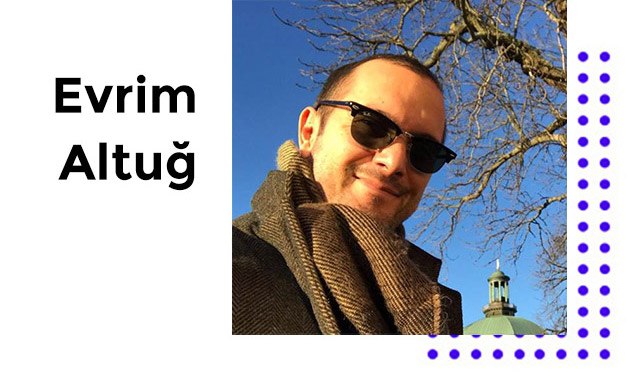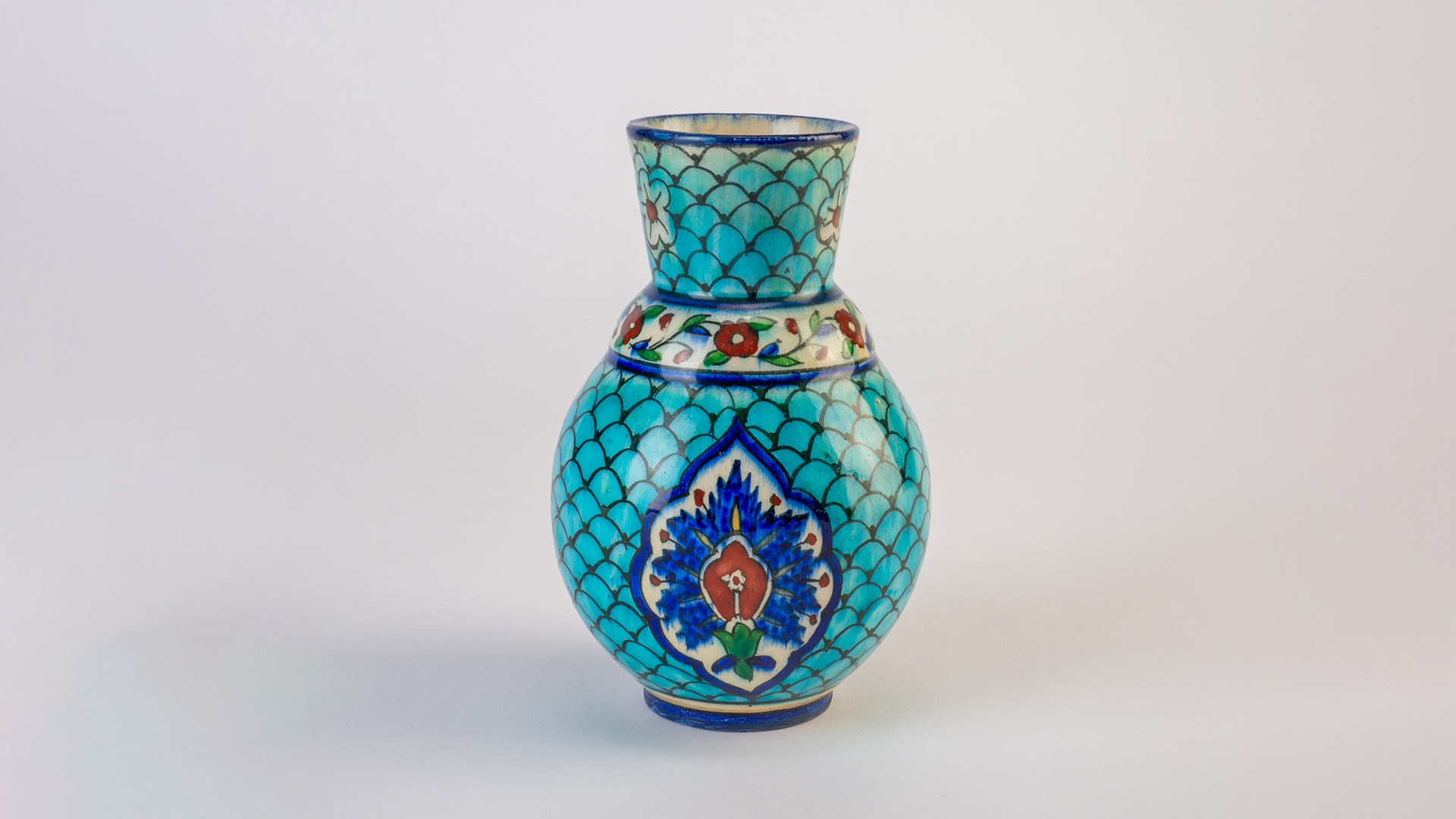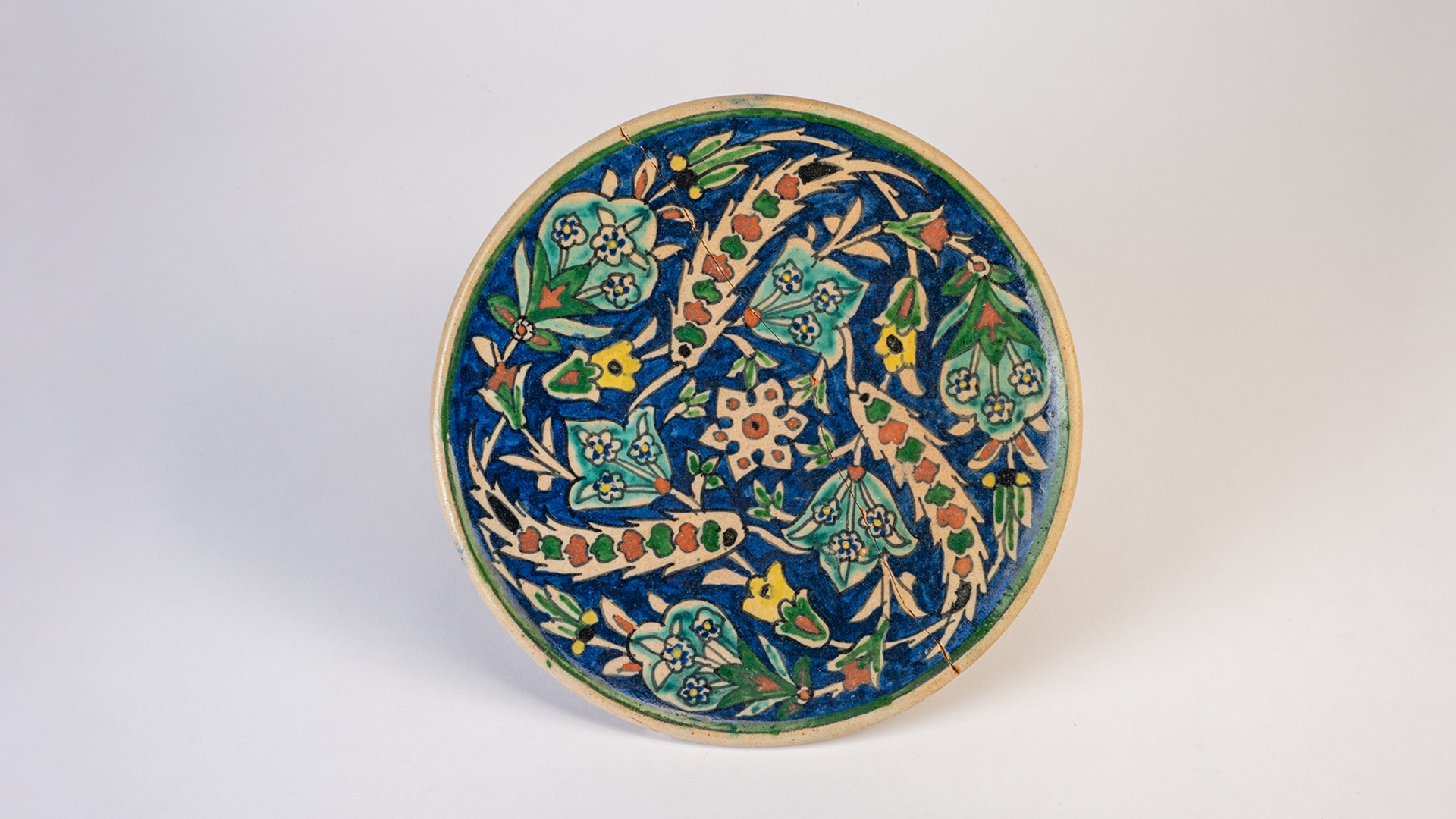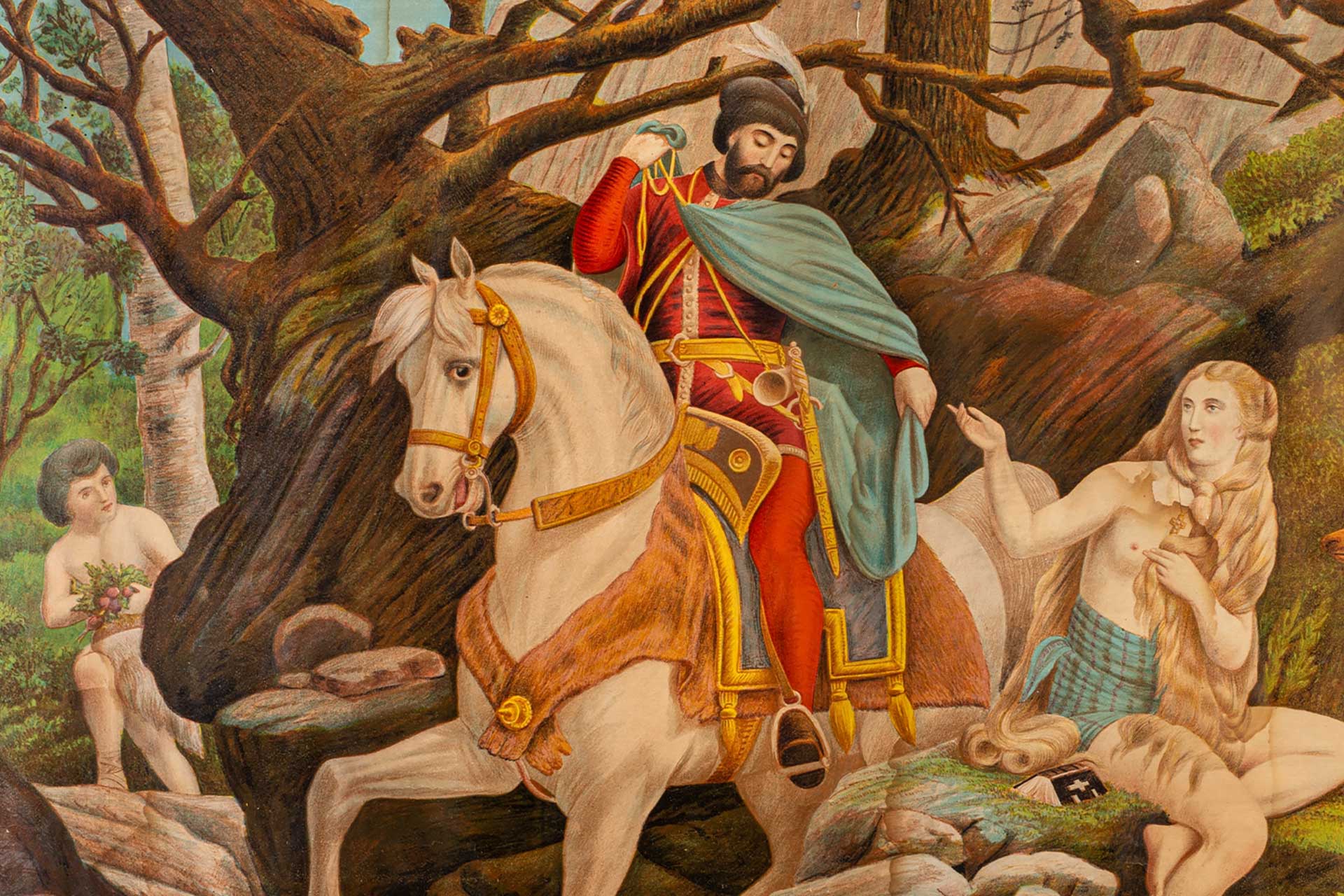
Pera Museum’s new permanent collection exhibition traces the legacy of “The Extraordinary Minas.” Centered on the story of inspiration and innovation in Kutahya tiles and ceramics, the exhibition is the result of nearly two years of teamwork. Curated by Yavuz Selim Guler, the exhibition highlights the delicate, nuanced character of Minas, who reflects both human strength and the fragility of history-reinforcing the museum’s commitment to cultural memory.
Celebrating its 20th anniversary this year, the Suna and Inan Kirac Foundation Pera Museum recently launched a very special collection exhibition. Titled “The Extraordinary Minas: A Story of Inspiration and Innovation in Kutahya Tiles and Ceramics,” the exhibition centers around the life story of Kutahya-based ceramic master Minas Avramidis (1877-1954), who was active between the late 19th and early 20th centuries. The Foundation’s strong interest in Kutahya ceramics stems especially from the late Suna Kirac’s genuine curiosity and devoted passion for this field.
According to Pera Museum Director M. Ozalp Birol, the same institutional structure and passion lie at the core of the Foundation’s multifaceted efforts to build its collection – whether through its collection of weight measurements or its archive of historical photographic memory. Director Birol recalls the happiness Suna Kirac felt during the later years of her life seeing a Kutahta-focused ceramics exhibition held at the Musée Jacquemart-André in France that was opened in 1913. He emphasizes that the Museum continues to honor her vision through its future exhibitions. In this context, Birol references Pera Museum’s past exhibitions “Coffee Break” and “Future Memories,” and praises the curator behind the new exhibition – Yavuz Selim Guler, a recent addition to the Pera Museum team and an acclaimed academic at the Istanbul Research Institute.
The exhibition “Extraordinary Minas: A Story of Inspiration and Innovation in Kutahya Tiles and Ceramics”, held at Pera Museum with the contribution of the Istanbul Research Institute, is enriched with selected works from the Suna and Inan Kirac Foundation’s Kutahya Tiles and Ceramics Collection, which now comprises a total of 54 pieces. According to the museum’s statement to the press and public, the exhibition – featuring works being presented to the public for the first time – visibly illustrates how tile production was shaped not only by traditional techniques but also by the social and cultural dynamics of its period. Curated by Guler, another notable feature of the exhibition is it bringing together, for the first time, Genovefa series created by Minas Avramidis, inspired by the Sotiris Christidis Lithograph Collection donated to the foundation at the beginning of 2025.
Organized by the Foundation established in October 2003 by Suna, Inan and Ipek Kirac, the event centers around Avramidis, who is described as a craftsman raised within the cultural diversity and social cosmopolitanism of the late Ottoman Empire. To provide historical context: master Minas Avramidis lived during the reign of Abdul Hamid II, the 34th Ottoman Sultan and 113th Caliph of Islam, who ruled between 1842 and 1918. This is significant, as Abdul Hamid II is known not only for his efforts to modernize an empire on the verge of collapse and territorial loss but also for his keen interest in the arts, especially through the educational institutions established in his era. His personal interests in Western classical music, opera and his ability to play the violin and piano – as well as his dedication to woodworking and painting – are also worth noting in this context.
Within this historical setting, Minas Avramidis born in 1877 in the Greek Orthodox neighborhood of Kutahya, is known for starting his professional life as a stonemason and later developing his career in tile and ceramic arts. In the 18th century, Kutahya tiles and ceramics were used to decorate many homes, mosques, churches, and coffeehouses throughout the Ottoman Empire. However, according to the museum, this delicate craft began to lose its competitiveness in terms of quality and style toward the end of the 18th century, especially due to imports from Europe and the Far East. As artisans shifted to other fields, Kutahya’s centuries-old ceramic tradition – except for a few remaining workshops – began to be viewed as a remnant of the past.
By the early 19th century, it is reported that only a handful of artisans remained who could still teach the craft. Yet by the end of the century, this field entered a phase of revival, particularly through the commissioning of Kutahya masters to restore Ottoman tiles, allowing the city to reconnect with its identity.
Trained in one of the few remaining workshops in Kutahya, Avramidis is particularly known for his narrative compositions and developed figurative works. Experts agree that Avramidis brought traditional motifs to life using a contemporary narrative style. His artistic influence reaching from Thessaloniki and Athens to Kutahya and even Jerusalem.



Avramidis first worked as a master craftsman at the “Kutahia” factory in Athens, where he shared his expertise with other immigrant workers. Later, he continued producing ceramics in Florina – a place where many Kutahya immigrants had settled due to its geographical resemblance to Kutahya. Following the population exchange, in 1926, he moved to Thessaloniki – then the second-largest city of the empire that had exited the Ottoman rule in 1912 and the birthplace of Gazi Mustafa Kemal Ataturk. In the new workshop he established there, he drew from the forms and tile patterns of Kutahya ceramics and developed his distinctive style by blending them with Byzantine and classical Greek ceramic traditions.
At the core of the exhibition is the “Story of Genovefa,” mentioned earlier and seen as clear evidence of this stylistic fusion. According to the museum, this illustrated series – produced by the artist in the 1910s – originates from Kutahya, a city known for pioneering tile production since the Beyliks Period. The series covers four scenes and depicts themes like loyalty, patience, and forgiveness through the narrative of Genovefa. It is noted that Avramidis created this story using his surname for the first time, inspired by a Karamanlidika translation prepared in the late 19th century. Additionally, it is believed that a Christidis lithograph, once displayed in the Greek neighborhood coffeehouses of the era, played a role in enhancing Master Minas’ creative inspiration.
Curator Yavuz Selim Guler states that with this exhibition, he aims to question the established understanding of color, form, and ornamentation in Kutahya ceramics. According to him, “The exhibition, which brings to light the interest in Kutahya, also aims to provide new perspectives to the collection by including tile masters.” Speaking about the exhibition, which stems from a study dating back approximately a year and a half, Guler explains that he focused on Avramidis’ life through a micro-historical approach.
Guler, who mentions conducting numerous readings during his research, notes that he also included Nikos Kazantzakis’ cult novel Christ Recrucified on his reading list. The curator explains that, through a section in which the author comments on a village coffeehouse in Likovrisi, he encountered a lithograph passage that introduced him to the European-origin “Story of Genovefa,” which had become popular among the Ottoman-Greek community of the time, and that this allowed him to draw parallel interpretations. In this regard, the story and its source of inspiration gain special significance by coming together for the first time after 110 years. On another note, Guler shares that during the time Avramidis lived and worked in Kutahya, he enjoyed frequenting Yordannis Tellaloglu’s coffeehouse, where he also created a large tile panel depicting the last Byzantine Emperor Constantine in front of the walls of Constantinople.
During a private tour of the exhibition with curator Guler, he explained that the event’s structure begins by reflecting a tile master’s relationship with tradition. The first section, titled “Heritage from the Distant Past,” showcases Avramidis’ connection to the nearly lost tradition of tile making. The second section of the exhibition, “Inspiration and Innovation,” reveals the imaginative worlds of the masters, followed by an exploration of the links between Kutahya artisans and the Seljuk and Ottoman traditions. The exhibition also emphasizes the multi-layered storytelling present on plates. In fact, the works produced by the artist demonstrate such a strong narrative quality that a newspaper from the period described him as an artist rather than merely a craftsman. The fourth section, referencing Yordannis’ coffeehouse, is titled “Inspiration and Work.” Additionally, the exhibition’s logo is typographically inspired by one of Avramidis’s tile illustrations created in Thessaloniki, which, unfortunately, has not survived to the present day.
Consisting of four main sections and one side section, the exhibition also benefits from contributions by the U.S. Library of Congress archives. Among the notable pieces and details are images of early 18th-century Kutahya tiles from the Surp Hagop Armenian Church in Jerusalem; a photograph of an early 20th-century “Cark Ustasi” (Wheel Master) from the Suna and Inan Kirac Foundation’s Arif Hikmet Koyunoglu Collection; and one of the collection’s rarest items—a censer (buhurdan). Dated between 1700 and 1750, this piece was crafted using a brush made from a goose feather tip filled with donkey mane and painted with cobalt blue, turquoise, manganese purple, red, green, and antimony yellow.
Another remarkable work in the exhibition is a ceramic plate dated between 1910 and 1920, with the Ottoman inscription “Bu da geçer ya Hû” (“This too shall pass”) in the central medallion. A 1908 plate features the Ottoman phrase “Yaşasın Vatan Hürriyet” (“Long live the homeland and freedom”). A particularly intriguing set of items in the exhibition includes a Lidded Raki Bottle, Meze Plate, Glass, and Tray, dated between 1890 and 1920.
With 20 featured works integrated into the museum’s collection and embracing historical narratives, the exhibition showcases over 200 years of history through plates, tile panels, candy bowls, milk jugs, vase sets, delicate vases and figurines depicting people and animals, and original archival materials on Ottoman architectural art—almost like a ceremonial parade. In summary, the exhibition celebrates Minas, a symbol of human strength and historical fragility, with a character rich in grace and detail, reinforcing the quality of Pera Museum’s universal memory wrapped in Kutahya blue.



